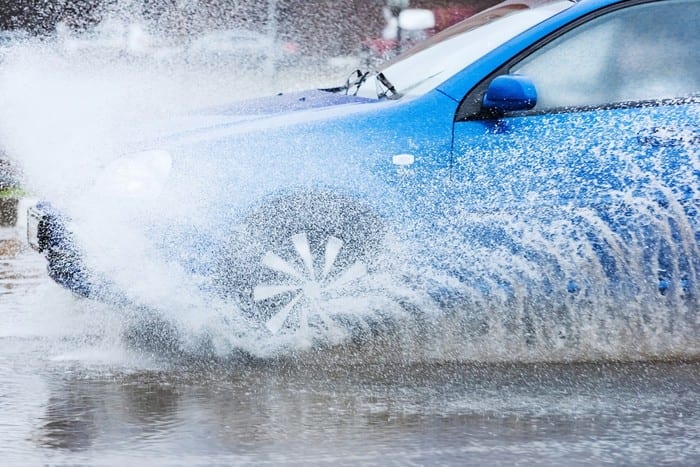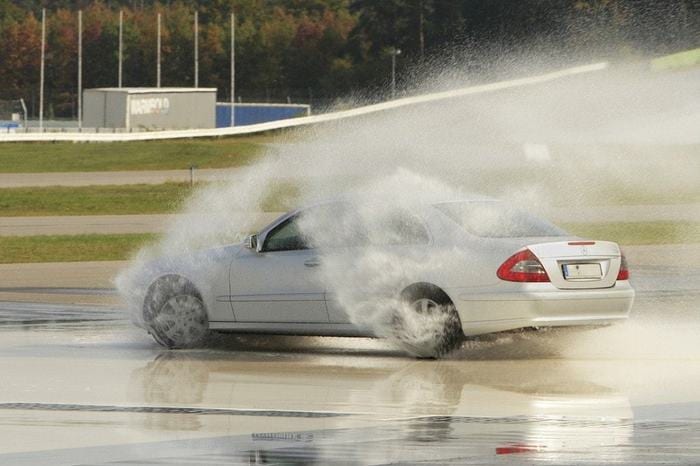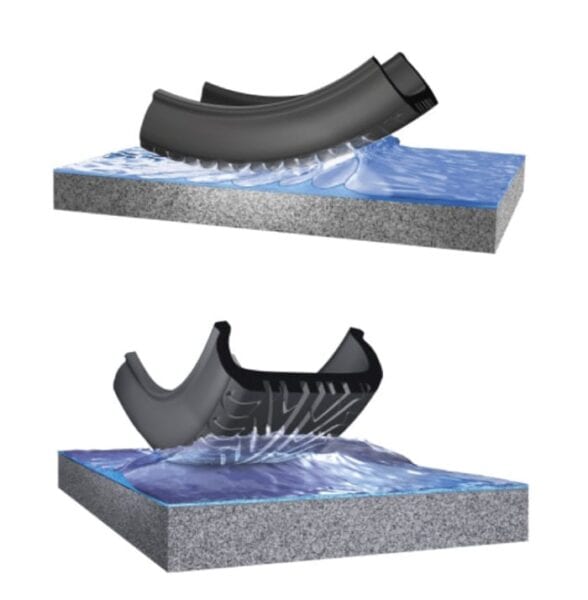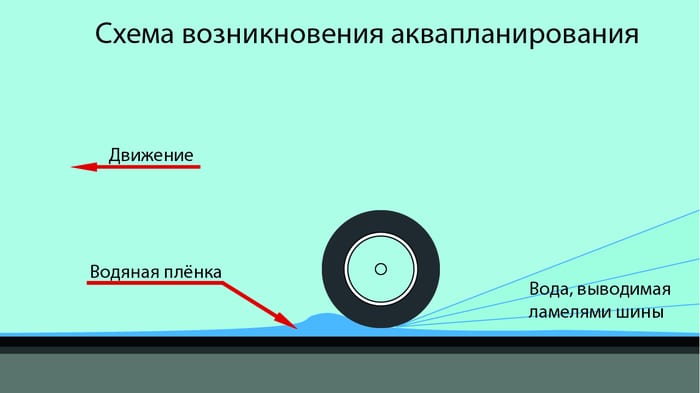
What is aquaplaning?
Content
It has been proven that most accidents occur in rainy weather, and the point is not in poor visibility, but in the most dangerous aquaplaning effect. Next, we will analyze what aquaplaning is, how to avoid it, and how to behave in such cases.
What is aquaplaning?
Aquaplaning is a situation in which the tires of a car are poorly in contact with the roadway due to a layer of water. Planning on the surface of the water occurs at high speed, which reduces the adhesion of the wheels to the road, and the car seems to float like a ship. The danger of the effect is that in an instant the driver may lose control of the car, an uncontrolled skid will occur with all the consequences. In this situation, aquaplaning is more difficult to ride on ice, since in the first case the wheel literally hangs in the air. In addition to high speed, there are other factors that provoke the loss of control over the car.

Factors Affecting Car Aquaplaning
So, high speed is one of the main reasons for the loss of control over the car and in general the culprit for more than 80% of all accidents, and such as:
- falling into a puddle at high speed;
- strong flow of water along the road;
- insufficient tread thickness or incorrect pattern;
- rough road, resulting in uneven distribution of water;
- different tire pressure;
- malfunction of the suspension, steering play, as well as overload of the car.
Tire pattern
The residual thickness of the tread at which the tire is guaranteed to perform its functions is 8 mm. It is extremely important that tire wear is as even as possible, which will allow you to achieve stable grip even with a minimum remaining pattern. Riding on “bald” tires on water looks like this: when you pick up speed over 60 km / h, water collects in front of the wheels, a wave forms. Due to the insufficient thickness of the water-repellent grooves, the wheels lose contact with the road, and a layer of water appears between them. The car “floats”, the steering wheel feels light, however, with the slightest wrong effort on it, the car will skid, an uncontrolled skid occurs. What to do in this situation:
- smoothly reduce speed, exclude driving in a neutral position, it is desirable to slow down the engine;
- do not exceed a speed of 40 km / h;
- add tire pressure 0.2-0.4 atmospheres above normal, equalize the value on all wheels;
- release the rear axle from the load.
If your region is predominantly rainy, then you need to choose the appropriate tires - water-repellent with a wide tread.
Water film thickness
The direct role is played by the thickness of the water layer. A wet road provides better traction, and deep puddles and a strong stream of water (rain and rain, or a breakdown of sewers), along with uneven road surface, instantly lead to aquaplaning. In this case, even the best tire is not able to fully maintain control of the car.
Traveling speed
Even with a thin layer of water, aquaplaning starts at 70 km / h. With every ten increase in speed, the coefficient of adhesion is diametrically opposite. For maximum safety, it is advisable to keep the speed at the level of 50-70 km / h. Also, this speed is safe for the engine, minimizing the likelihood of water getting into the engine cylinders, shorting the generator and the electrical circuit.
Suspension Condition
The consequence of a faulty suspension is increased play between moving parts. Because of this, the car goes to the side, or it is thrown along the road, constant steering is necessary, and a sharp movement of the steering wheel can lead to a skid. Also try to brake carefully, without sharp pressure on the brake pedal, which will keep the brake discs in working order, otherwise their deformation is inevitable (water gets on the hot metal).

Why is aquaplaning dangerous?
The main danger from hydroplaning is loss of control of the car, which leads to an accident. The great danger is that the classical use of skills from skidding does not save. For example, a front-wheel drive car will come out of a skid by pressing the accelerator pedal sharply, as a result of which the car will level out. In the case of aquaplaning, it is more difficult: due to the lack of a contact patch, the drive wheels will simply slip, which will lead to worse consequences.
What to do in this situation?
Not a single driver is safe from aquaplaning, even the most expensive and safe car can get into this situation. Sequencing:
- If an effect occurs, hold the steering wheel firmly, in no case do not rotate it while trying to level the car, on the contrary it will aggravate the situation. If you hold the steering wheel tightly, the car will simply scroll around its axis, otherwise the active “taxiing” will throw the car from side to side, which is fraught with a blow to an obstacle or an oncoming car.
- Release the brake pedal or depress it easily with quick and short movements. Try to stop the engine by lowering the gears. On the Tiptronic automatic gearbox, manually lower the gears by shifting to “-”.
- Keep calm. Any panic will aggravate the consequences, a clear understanding of the situation is important, as well as a cold calculation.
How to avoid aquaplaning?

Important rules that will not allow the effect of planning:
- Observe the speed limit, while the maximum speed should not exceed 70 km / h;
- check the tire pressure, it should be the same everywhere;
- the residual tread thickness should not be less than the prescribed values;
- Avoid sudden acceleration, braking and sudden rotation of the steering wheel;
- do not overload the trunk;
- Seeing a puddle in front of you, slow down in front of it.
Signs of Aquaplaning Resistant Car Tires
Not every tire is able to provide maximum water drainage. For example, the world famous company Continental has special “rain” tires of the Uniroyal Tires series. In long-term tests, the best efficiency of water removal from the wheels, maximum traction and stable control over the car were revealed. The main thing to remember is, no matter what the quality tire is, no matter what the latest safety technologies the car is equipped with, no one is safe from aquaplaning. Only compliance with the speed limit, distance and interval, as well as maintaining the vehicle in good condition will avoid the detrimental effect of aquaplaning.
Questions and answers:
Which tires do the best at aquaplaning? Rain tires are ideal. A feature of these tires is a deep tread pattern that effectively removes water from the tire, providing stable grip on hard surfaces.
What affects aquaplaning? This effect is primarily influenced by the tread pattern and the degree of rubber wear. For effective water drainage, the tread must have frequent, straight, deep grooves.
Why is aquaplaning dangerous? When aquaplaning (at high speed the car drives into a puddle), the car behaves as if it hit the ice, even worse, because the wheel completely loses its contact with the road.
What is the constant thickness of the water layer for a longitudinal aquaplaning test? Different puddle depths may be required for the aquaplaning effect to occur. The main thing is not to fly into it at a speed of 40-70 km / h, depending on the condition of the tires.
3 comment
saneek
yeah, I got into aquaplaning somehow))) I didn’t fly well into the ditch, they didn’t save
eyeslogs
hello, how can i solve this problem with this page showing? eyeg
pilot
Aquaplaning is calculated using the formula V=62 √P
where 62 is a constant P-pressure in pneumatics
at pressure “2” the onset of hydroplaning speed is 86 km/h
62x1.4=86km/h do not exceed.